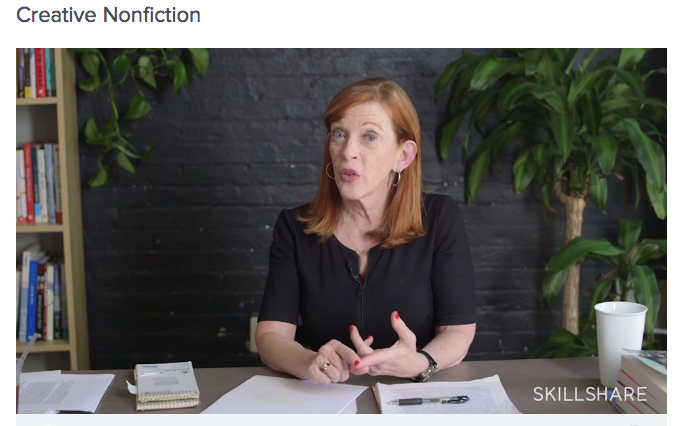Bestselling author and New Yorker writer Susan Orlean breaks down a semester’s worth of storytelling instruction in a two-hour online video course for Skillshare.com. For $19, you get tips and insight on 14 topics, from finding a story idea to collaborating with editors. Plus, a writing assignment: “Write a short piece of creative nonfiction on the most mysterious person you know.” One discussion board has already launched with the question “What’s your favorite piece of creative nonfiction?” (One answer so far: Sasha Frere-Jones’ 2010 New Yorker profile of James Murphy of LCD Soundsystem. “Its dialogue and description create an energy that seems to match the music, and Frere-Jones masterfully balances details and bigger ideas about trends and culture,” writes Alyssa Demirjian.)
Here's some of what you'll get:
1: Introduction (6 minutes, 43 seconds)
2: Subject: Finding Your Topic (9:35)
3: Subject: Finding “The American Male at Age Ten” (7:15)
4: Research: Preparing for Reporting (9:10)
5: Research: Reporting (9:16)
 6: Research: Organizing Notes (9:59)
6: Research: Organizing Notes (9:59)
7: Writing: Elements of a Story (9:41)
8: Writing: Dialogue and Quotes (6:02)
9: Writing: Description (4:45)
10: Writing: Expert Opinion (3:16)
11: Writing: Conclusions (10:07)
12: Editing: Revising (9:58)
13: Editing: Collaboration (3:08)
14: The Ongoing Work of a Writer (8:51)
Here's some of what you'll get:
1: Introduction (6 minutes, 43 seconds)
“You may ask why nonfiction. And I will make a very powerful argument for why learning to write effective nonfiction is valuable even if your interest as a writer is fiction, poetry, whatever genre. First of all, writing well is writing well. ... I happen to think nonfiction is a great basic primer on writing because you're working with the craft of fact, and using techniques to make that effective, elegant, creative."
2: Subject: Finding Your Topic (9:35)
“How do you find a good story idea? ... How do you figure out if it's an idea that will work? ... In practical terms, is this subject too narrow or too broad?"
3: Subject: Finding “The American Male at Age Ten” (7:15)
“He could have been any kid, so his individual story wasn't the motivation as much as the idea that it explored the very universal larger theme of childhood."
4: Research: Preparing for Reporting (9:10)
“I think the best reporting often can feel kind of uncomfortable.”
5: Research: Reporting (9:16)
“The writer should know much, much, much more than what they offer the reader. The reader without even being aware of it is going to be affected by the depth of knowledge that the writer has.”
 6: Research: Organizing Notes (9:59)
6: Research: Organizing Notes (9:59)“…Good nonfiction writing is reporting, thinking and writing. The reason I linger on the thinking is that it’s the one we often forget about.”
“By typing up your notes you reacquaint yourself with them in a deeper way. … You’re also beginning the editing process, the choice-making.”
7: Writing: Elements of a Story (9:41)
“You’ve got to be constantly aware of the texture and the rhythm of your stories.”
8: Writing: Dialogue and Quotes (6:02)
“If you can do reporting of subjects interacting with each other … the great advantage you have, then, is that textural exchange, which is the world presented to the reader without your interference.”
9: Writing: Description (4:45)
“If you take your favorite story and break out what percentage of them is pure description, in the best stories you’ll find that it is a little bit less than you might expect. That is because the descriptions that are in the story are really vivid, really memorable, and remarkably evoke enough that the reader fills in the remainder.”
10: Writing: Expert Opinion (3:16)
“Almost never is it very appealing to directly quote an expert.”
11: Writing: Conclusions (10:07)
“No story is ever finished. They end. They do not have to come to a crescendo and a completion that includes a recap and an assessment of everything you’ve already read. In fact, it’s almost an insult to the reader, to do that.”
12: Editing: Revising (9:58)
“There are three big questions to think about when you’re revising. One … is: How confident does the piece sound? Anywhere that you find an equivocation (“I think,” “perhaps,” “might have”) … step back, and revise. The reader wants to feel that the writer knows the material and is telling the story in a really authentic way.”
13: Editing: Collaboration (3:08)
“The easiest way to be comfortable hearing criticism, I think, is to not look at your piece as being done. The minute you think it’s done you’re no longer really receptive to input.”
14: The Ongoing Work of a Writer (8:51)
“There’s a lot of fear of thesauruses, which I do not have. Because I think a lot of times when you realize you’ve used the same words too many times – open yourself up to learning new words. Don’t use a thesaurus in a sloppy way where you slam in words you don’t really understand or that actually have connotations that are inaccurate. But work on language. It’s an easy thing to do. Read, collect words, enjoy words, appreciate them, and develop a bigger and bigger toolkit of language to use in your pieces to make them better, brighter, more vivid, more unique.”



